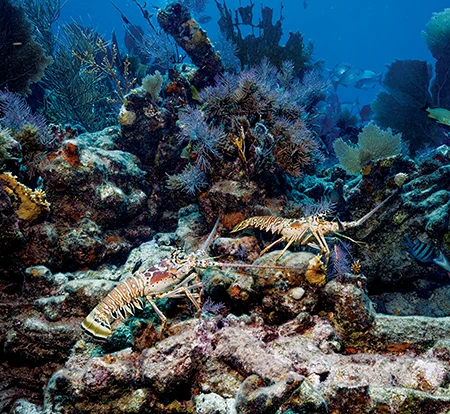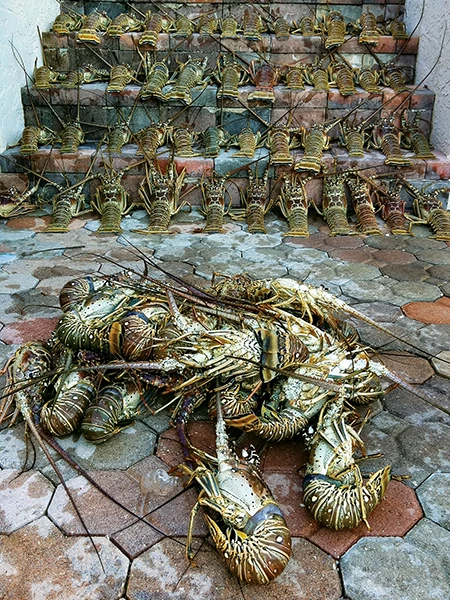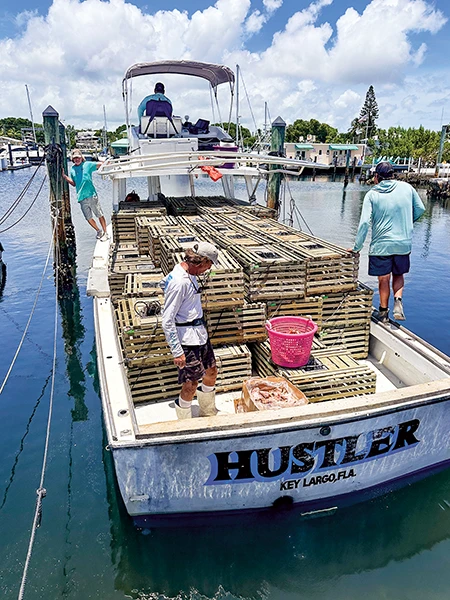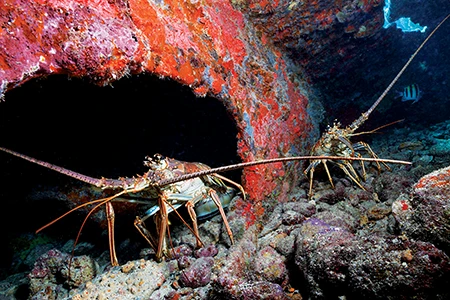Her legs move quickly as she scrambles over the sand toward a large coral reef. It’s a bold and risky move, as the expanses of sand between coral patches are full of predators waiting to take advantage of a lone spiny lobster.
A nurse shark appears overhead. As the lobster dashes to the reef’s edge, finding a small ledge, the shark follows. The hiding spot is not great, but it is good enough to discourage the shark. Time passes, and she is alone again. She begins to move, searching for openings in the reef — searching for her perfect mate.
He normally lives among large groups of other spiny lobsters in dens within the reef. But for now he is alone and has prepared his own den for one purpose: He needs to lure her in so he can mate with her. He patiently waits for her to appear at the entrance. When she does, he will be ready.

She grasps the ledge with her legs, climbing over to see a large wall of diverse corals and many possible dens. She continues to walk until she spots an entrance. There it is. Slowing her walk, she positions herself in view of the entrance. He sees her, and they face each other, spreading out their long antennae and beginning to use their smaller antennules to try to smell each other.
In response to her display, he releases a spray of urine directly toward her from small nephropores on the front of his head. The urine contains pheromones that tell her everything she needs to know to evaluate his suitability as a mate. It’s a critical decision; she must determine if he will provide her with strong offspring and reliable protection during this vulnerable time. She makes her choice — he is the one.
She signals her readiness by entering his den. Together, they move awkwardly like clumsy dancers and then lock tightly in a belly-to-belly position. He successfully deposits a packet of sperm onto her belly. Her hard exoskeleton is gone from molting, leaving her vulnerable for the time it will take to regrow her hard exterior. While she is soft and needs protection, her mate will guard her and keep her safe in his den for several days.
Her exoskeleton hardens, and she is now ready to fertilize her eggs, which she has safely tucked under her tail. She uses her legs to scratch open the sperm packet and successfully fertilizes her hundreds of thousands of bright orange eggs. With her shell hardened and eggs fertilized, her time with her mate has ended, and she must go.


The male remains in his den, and when another female comes to the opening, he will release more of his pheromone-laden urine to lure her in. And so the cycle repeats.
She must now take care of her eggs so they can hatch successfully. The swimmerets on her tail, which are like small paddles, let her continually flush the eggs with oxygenated water and keep them clean. The egg tending lasts up to four weeks, during which she is very attentive. When the eggs are about to hatch, she moves from the reef to deeper water to release the hatching larvae into the currents, which sweep thousands of her larvae out to sea.
Spiny lobster larvae, called phyllosomes, travel thousands of miles on ocean currents for up to a year before they metamorphose into a postlarval phase called a puerulus. This short but critical phase is when the lobster navigates from the open ocean to a nearshore habitat, settling in seagrass, mangrove roots, and algae beds. It is a treacherous time, and many larvae are lost to a host of hungry and unforgiving predators.
The larvae that survive this settlement spend the next two years growing, molting, and living relatively solitary lives. They learn how to avoid predators and successfully feed on a variety of prey. As they become juveniles, they begin congregating in areas that afford more protection.
Mature adult spiny lobsters move from their inshore habitats back out to the reefs. They make their new homes in the protected crevices and caverns of the coral reefs and become very social. Their color and texture mimic the reef as they mature, making it difficult for predators or prey to see them.


Adult spiny lobsters are gregarious and pack tightly together in social groups in medium- to large-sized dens on the reefs. While it may appear to be a safety-in-numbers strategy, research shows no significant survival benefit in residing on the reef as an individual lobster versus a group. Sharing den space and living communally, however, helps lobsters find shelter more quickly, reducing their time seeking shelter and their exposure to predation.
Lobsters communicate a great deal of information to each other by emitting urine filled with chemical messages. Males and females use urine-borne signals to communicate social status among members of the group. Dominant lobsters release significantly more urine than the smaller subordinates. They also use the signal to initiate large social aggregations.
Signals in urine are capable of inducing avoidance behaviors in solitary individuals. In addition to urine, injury-related cues can leak into the environment due to deadly damage from a predator. Other lobsters will avoid dens with these alarm cues.
Lobsters stay in their dens during daylight hours to avoid predators and emerge a couple of hours after dark to forage for food. While lobsters will eat almost anything, their favorite prey are snails, clams, crabs, and urchins. The lobsters emit chemical cues to signal for the group to return to the safety of their dens several hours before sunrise.
In autumn, spiny lobsters in the Florida Keys, Boca Raton, Bimini, and Grand Bahama embark on mass migrations. Thousands of individuals line up one after another in long single-file chains and walk for days. This behavior is peculiar since they are nocturnal and do not normally appear out of their shelters during the daytime. Visual cues associated with the movement of other lobsters initiate the lineup. They stay very close and maintain their positioning by flicking and touching each other with their antennae.
We don’t fully understand the migration’s function, but it could be to get to better feeding grounds, find better shelter for molting, or reduce habitat crowding. New research has shown that spiny lobsters possess a magnetic compass sense, like that found in birds, sea turtles, and sharks. They can derive positional information from the Earth’s magnetic field to determine the direction of home and guide them during their spectacular autumn migration.
Lobsters are harvested globally, and the market for them is lucrative. Canada has recently dominated the global lobster market and is poised to continue to expand its reach. Florida spiny lobsters were among the top three most valuable fishery landings in 2020, accounting for $25 million in state revenue. Recreational catches in Florida peak during the July mini-season, when divers are allowed to take lobsters as part of a two-day sport season. Regular lobster season is from August to March. A spiny lobster must have a carapace length of at least 3 inches (7.6 centimeters) to be legal for harvest. This size indicates the lobster is about 2 years old and has likely reached sexual maturity.

Removing large numbers of lobsters from marine ecosystems can have unintended negative consequences. Spiny lobsters were long considered scavengers because of the effectiveness of dead bait in traps, but we now know they are selective feeders that eat mostly live prey. They may be one of the most dominant bottom-dwelling predators on the reefs. Their selective predation profoundly affects the community structure, species composition, and prey distribution.
Coral reefs are some of the most diverse ecosystems on Earth, even though they cover less than 1% of the world’s oceans. They provide habitats and feeding, spawning, and nursery grounds for many species. With many different threats to coral health, corals are in global decline.
Several types of snails, including Drupella, specifically feed on coral. Lobsters are snail predators, so when lobster numbers shrink, the snails become too abundant. Larger snail populations can be catastrophic for coral reefs. In the early 1990s the Drupella outbreak on Ningaloo Reef in Australia reduced coral cover by 75% in parts of the reef.
Marine protected areas represent an opportunity for species to recover. The Western Sambo Ecological Reserve in Florida is a fully protected marine zone that is home to spiny lobsters. A long-term ecological study found that the reserve was home to the largest lobsters, which were able to grow older and larger because of the protection.
And that brings us back to our female. How long will she live? Did she avoid lobster traps during her many migrations over the sand? Did she return to the reef after ushering her new larvae into the ocean currents? I hope she did, and I hope many of her offspring grew up and made it to the reef to continue the cycle of life.
Explore More
Learn more about the mating activities of spiny lobsters in this video.
© Alert Diver – Q4 2024